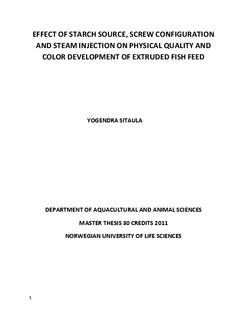| dc.contributor.author | Sitaula, Yogendra | |
| dc.date.accessioned | 2012-04-23T07:38:07Z | |
| dc.date.available | 2012-04-23T07:38:07Z | |
| dc.date.issued | 2012-04-23 | |
| dc.identifier.uri | http://hdl.handle.net/11250/186077 | |
| dc.description | Physical quality of feed was affected by starch source, screw configuration and steam injection into the barrel. Potato starch gave the highest pellet durability, water stability and hardness. Screw configuration LRLR gave the highest durability, water stability and hardness. Likewise, no steam injection in the barrel gave the highest durability, water stability and hardness. The results also showed that image analysis discriminated among the feeds. Contrast and brightness changed with starch source, but was not affected by other processing parameters such as screw configuration and steam injection. Image analysis alone cannot be used to describe the physical quality such as durability or hardness but it can help explain the process undergone during extrusion, which might explain in part about the physical quality. | no_NO |
| dc.description.abstract | The study investigated the effect of starch sources, screw configuration, and steam injection on physical quality of extruded fish feed. Pellet durability, water stability and hardness were measured and analyzed. Four starch sources; pregelatinized potato starch, potato starch, whole wheat and wheat starch were used in the production of extruded fish feed. Three screw configuration types; polygon-2L, polygon-LR, and LRLR were used during production of feed. Similarly, steam injection and no steam injection in barrel were used for the production of the extruded fish feed. Contrast, brightness and entropy were used to analyze differences in color. Four diets; Pregelatinized potato starch, potato starch, whole wheat and wheat starch showed varied results. In general, potato starch diets gave the highest pellet durability, hardness and water stability than the wheat starch diets. Pregelatinized potato gave highest pellet durability and water stability. Hardness (length, width and breaking force) was also higher for pregelatinized potato starch. Potato starch gave the highest hardness. Screw configuration LRLR gave the highest pellet durability and Polygon-LR had the lowest. Screw configuration Polygon-2L and LRLR gave higher breaking force than Polygon-LR. There was no difference in the effect of screw configuration on length and diameter. No steam injection in the barrel gave a higher pellet durability and water stability. Steam pressure did not affect length, diameter and breaking force of the pellet. Wheat diets gave brighter pellets than the potato starch diet, indicating that extent of maillard and caremelization differed for different diet compositions. Screw configuration and steam pressure did not show significant effect on contrast and entropy of the picture. Whole wheat gave lowest contrast and highest entropy. Wheat starch gave highest contrast and lowest entropy. Overall results indicated that starch source and processing parameters affected physical quality of pellets. Color analysis showed that starch sources used in feed production had influenced color development during extrusion, indicating possible nonenzymatic browning of the feed. | no_NO |
| dc.description.sponsorship | department of aquaculture and animal sciences | no_NO |
| dc.language.iso | eng | no_NO |
| dc.publisher | Norwegian University of Life Sciences, Ås | |
| dc.subject | pelleted feeds | no_NO |
| dc.subject | color development | no_NO |
| dc.subject | extrusion | no_NO |
| dc.subject | technology | no_NO |
| dc.subject | feeding | no_NO |
| dc.subject | pellets | no_NO |
| dc.subject | fish | no_NO |
| dc.title | Effect of starch source, screw configuration and steam injection on physical quality and color development of extruded fish feed | no_NO |
| dc.type | Master thesis | no_NO |
| dc.subject.nsi | VDP::Agriculture and fishery disciplines: 900::Fisheries science: 920 | no_NO |
| dc.source.pagenumber | 28 | no_NO |
